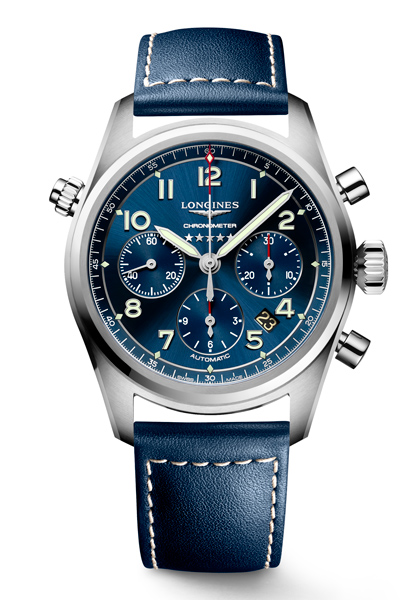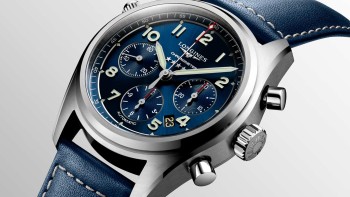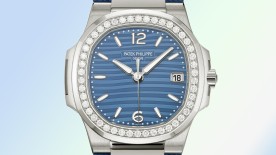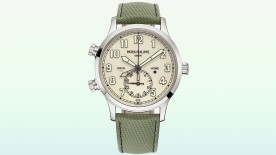Courchevel, February 12, 2023. Swiss skier Marco Odermatt is preparing to make his bid for gold at the Alpine World Ski Championships 2023. Ahead of him is L’Eclipse: a descent of almost 1,000 metres of daunting jumps and turns, with an average gradient of 30%. The surface is rock-hard — as we’d witnessed for ourselves when we joined teams from Longines and Fédération Internationale de Ski (FIS) for their inspection of the track. Seconds before the start, Marco Odermatt beat his fist on his chest, determined to snag however many hundredths of a second it would take to secure first place.
The pressure was on for the 25-year-old phenomenon, a Longines ambassador since 2019. Three days earlier he’d set his sights on a podium finish in Super-G but missed out by a mere 11 hundredths, finishing fourth behind France’s Alexis Pinturault. Marco Odermatt knows he’s one of the favourites for this downhill, but who would have imagined he would streak across the finish line after a near-perfect performance, in a whisker over 1:47 — 48 hundredths ahead of the other favourite, Norwegian Aleksander Kilde?
Such is life for the top ten skiers in the world. Through grit and determination, they push beyond their limits to reach performances that Longines measures with one hundredth of a second precision. That make or break one hundredth of a second. Swiss skier Jasmine Flury knows what that means. The day before Marco Odermatt’s victory, she claimed gold at the women’s downhill in Méribel in 1:28.03, just four hundredths of a second, a hair’s breadth, ahead of her nearest rival.

The benefit of technology
Only chronometers capable of the utmost precision, backed by the latest and most innovative technologies, can time events with this level of accuracy. While FIS rules require timing to the nearest hundredth of a second for international competitions, the equipment developed by Longines and Swiss Timing, part of Swatch Group, can record skiers’ race times to one thousandth of a second — providing valuable data which these athletes use to analyse and improve their performance.
Cutting-edge innovations include live tracking and motion sensing, which the Official Partner and Official Timekeeper of the Fédération Internationale de Ski (FIS), Official Timekeeper of the FIS Alpine Ski World Cup and FIS World Ski Championships uses at the major Alpine ski races. From Zermatt to Val d’Isère, from St. Moritz to Wengen, from Kitzbühel to Méribel and Courchevel for the 2023 World Championships, there is always a Longines technician on the slopes to guarantee that the timing equipment is doing its job. One of the latest innovations at the World Championships is the Longines Live Alpine Data System (LLAD). Comprising a chip attached to the skier’s boot and equipped with a radar and motion sensor, it enables real-time measurement of the skier’s speed, acceleration and deceleration, time taken to reach 100 kph and an analysis of jumps. Another piece of tech, a photo finish camera, records skiers’ exact finish time.
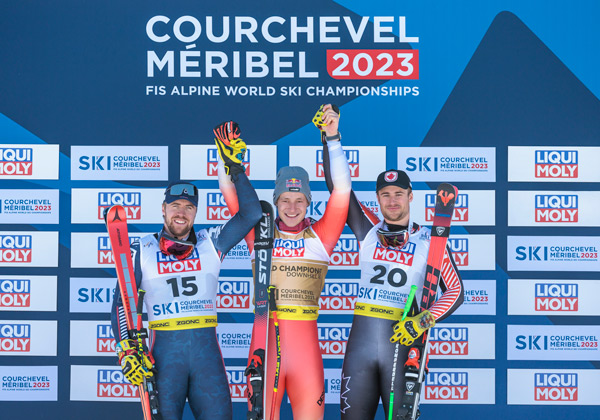
Technology on the move
Spelled out on the clocks in the stadiums, on the giant screens and on ambassadors’ equipment – the likes of Mikaela Shiffrin, Mélanie Meillard, Loïc Meillard, Clément Noël, Alex Vinatzer and Marco Odermatt – the Longines name is part of the Alpine landscape. The Saint-Imier brand, which is known for its precision watches, has been a partner to world skiing for almost a century, since its first appearance on the slopes in 1924 at the International Winter Sports Week in Chamonix. In 1937 it trialled an electronic system that automatically triggered the chronometers. In 1945 in Crans-Montana it installed a photoelectric light beam barrier at the start gates. The Chronoson system, introduced in 1951, counted down the seconds to each skier’s start. Quartz made its entrance in 1956 while the first televised events, in the 1960s, spurred Longines to take technology further and give viewers the experience of being able to see split times as well as skiers’ speed.

A century and counting
For the world’s top skiers and for the fans cheering them on, Longines remains synonymous with reliability, performance, a pioneering spirit and precision: a quality illustrated by the World Championships official watch. Presented to the season’s top-performing athletes, the Longines Spirit in steel comes in two versions, both chronometer-certified. The 40mm size displays hours, minutes and seconds thanks to an automatic movement. The 42mm rendition is fitted with a chronograph movement with the addition of a date display. All these indications are clearly visible on a matte black, grained silver or sunburst blue dial that also features the five Longines stars. They represent the longevity and expertise of the Saint-Imier brand; a fixture of the Alpine ski circuit for close to a century… and for many more years to come!
